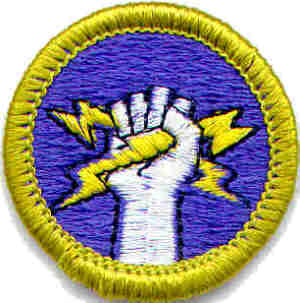
Electricity
- Show magnetic attraction and repulsion. Make and
use a simple electromagnet.
- Explain the difference between a direct current
and an alternating current. Tell the common uses
of each.
- Make a simple drawing to show how a chemical cell
and an electric bell work.
- Explain why a fuse blows or a circuit breaker
trips. Tell how to find a blown fuse or tripped
circuit breaker in your home. Show how to change
the fuse or reset the circuit breaker safely.
- Explain what overloading an electric circuit
means. Tell what you have done to make sure your
home circuits aren't overloaded.
- Demonstrate how to repair a plug on an appliance
cord.
- Show that you know first aid for a person who is
unconscious from electrical shock.
- Show on a floor plan of a room in your home the
lights, switches, and outlets. Show which fuse or
circuit breaker protects each.
- Read an electric meter. Figure an electric bill
from meter reading.
- Explain ten electrical terms such as volt,
ampere, watt, ohm, resistance, potential
difference, rectifier, rheostat, conductor,
ground, circuit, or short circuit.
- Do any TWO of the following:
- Connect a buzzer, bell, or light with a
battery. Have a key or switch in the
line.
- Make and run a simple electric motor (not
from a kit).
- Build a simple rheostat. Show that it
works
- Hook a model electric train layout to a
house circuit. Tell how it work.
- Connect a buzzer, bell, or light with a
battery. Have a key or switch in the
line.

Electronics
- Do the following:
- Draw a simple schematic diagram. It must show resistors, capacitors and transistors or integrated circuits (ic's). Use correct symbols. Label all parts.
- Tell the purppose of each part.
- Do the following:
- Show the right way to solder and unsolder.
- Show how to avoid heat damage to parts.
- Tell about the function of a printed circuit board. Tell what precautions should be observed soldering them.
- Select ONE of the following:
- Tell how you can use electronics for a control purpose. Build a circuit to show this.
- Tell about the basic principles of digital techniques. Show how to change three decimal numbers into binary numbers. Show how to change three binary numbers into decimal numbers. Build a circuit to show digital techniques.
- Tell about three audio applications of electronics. Build a circuit to show audio techniques.
- Do the following for the project you built in
requirement 3:
- Show how to read the schematic diagram of the project.
- Show how the project works. To the best of your ability tell how it operates.
- Do the following:
- Show how to solve a simple problem involving current, voltage and resistance using Ohms Law.
- Tell about the need for and use of test equipment in electronics. Name three types of test equipment. Tell how they operate
- Tell about about three jobs in clectronics. Tell what training is needed for each job.
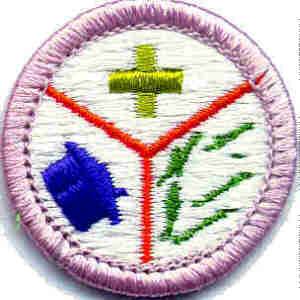
Emergency Preparedness
- Earn the First Aid merit badge.
- Do the following:
- Tell what you would do to prevent injury
and possible loss of life to yourself and
others in each of the following
emergencies: fire or explosion at home
and in a public building, car stalled in
blizzard or desert, motor vehicle
accident, mountain accident, food
poisoning, boating accident, search for
lost person, lost or marooned group, gas
leak, earthquake, flood, tornado or
hurricane, atomic emergency, and
avalanche (snow or rock).
- Show that you know what to do in at least
TWO of the above.
- Tell what you would do to prevent injury
and possible loss of life to yourself and
others in each of the following
emergencies: fire or explosion at home
and in a public building, car stalled in
blizzard or desert, motor vehicle
accident, mountain accident, food
poisoning, boating accident, search for
lost person, lost or marooned group, gas
leak, earthquake, flood, tornado or
hurricane, atomic emergency, and
avalanche (snow or rock).
- Show how you could safely save a person from the
following:
- Touching a live electric wire
- A room with carbon monoxide or other
fumes or smoke.
- Clothes on fire.
- Drowning using non-swimming rescues
(including ice accidents).
- Touching a live electric wire
- Tell the things a group of Scouts should be
prepared to do, the training needed, and the
safety precautions to be taken for the following
emergency service:
- Crowd and traffic control.
- Messenger service and communication.
- Collection and distribution services.
- Group feeding, shelter, and sanitation.
- Crowd and traffic control.
- Take part in an emergency service project, either
real or a practice drill.
- Show three ways of attracting and communicating
with rescue planes.
- With another person, show a good way to move an
injured person out of a remote and rugged area,
conserving the energy of the rescuers.
- Do the following:
- Prepare a written plan for mobilizing
your troop when needed to do emergency
service. If there is a plan, explain it.
Tell your part in making it work.
- Take part in at least one troop
mobilization. Describe your part.
- Show the personal "emergency
pack" which you have prepared to be
ready for a mobilization call. Show a
family kit (suitcase or box) for use by
your family in case an emergency
evacuation is needed. Explain the need.
- Prepare a written plan for mobilizing
your troop when needed to do emergency
service. If there is a plan, explain it.
Tell your part in making it work.
- Show proper use of ropes and line for rescue work
by doing the following:
- Tie knots for joining lines. Tie knots
for shortening or adjusting lines. Tie
knots for lashings.
- Lower a person from a height sufficient
to show how.
- Coil and accurately throw light and heavy
50-foot heaving lines.
- Tie knots for joining lines. Tie knots
for shortening or adjusting lines. Tie
knots for lashings.
![]() One of two choices for
the Emergency Eagle Requirement
One of two choices for
the Emergency Eagle Requirement
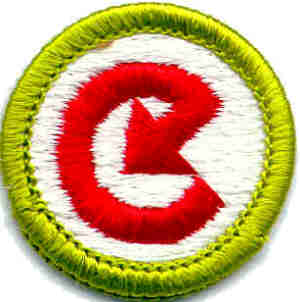
Energy
- Demonstrate the flow of heat energy. Use your demonstration to explain it in your own words the ideas of heat temperature, kinetic energy, calorie, and the laws of thermodynamics.
- Give an example of each of the following forms of energy: heat, light, mechanical, electrical, chemical, atomic. Prepare a table showing devices for each form of energy that will convert in into another form of energy. Describe the idea of tradeoffs in energy use.
- Make a color chart showing the world's known and estimated energy resources. Explain how long each is expected to last based on today's best estimates. Tell where you got your information.
- Do the following:
- Prepare charts showing:
- What energy sources supply the United States with its energy.
- What portion of our energy is used by homes, business, industry, and transportation.
- What fuels are used to generate America's electricity.
- Tell what is being done to make any three
of the following produce more energy.
Include cost, pollution, and safety
problems n your explanation.
- Nuclear fission generators
- Nuclear fusion generators
- Cogeneration
- The sun
- The wind
- Geothermal
- The oceans
- Tell how out lives in the United States might be affected in energy supplies could not meet our present demands.
- Prepare charts showing:
- Show and explain to your counselor two articles from a current newspaper or magazine about the use or conservation of energy. Tell why these articles are important to the United States and why they are important to you.
- Conduct an energy audit of your home. Prepare a
written report in two parts:
- Describe ways that your family can use energy more wisely.
- Keep a record of what you have done to save energy for a 2-week period.
- Find out and describe in a notebook 10 different examples of energy waste going on in your town. Suggest in each case possible ways to reduce this waste. Find out and write in your notebook five examples you have observed of pollution from energy use. Suggest in each case how this pollution might be reduced.
- Give a talk titled "Energy: Why We Need It and How We Can Use It Better". Use all of the materials you have prepared in requirements 1 through 7. Choose as your audience your counselor, a den of Cub Scouts, or another group approved by your counselor.
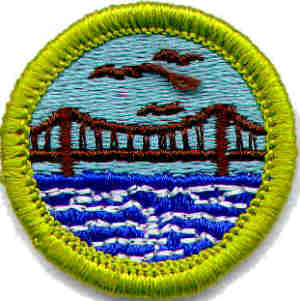
Engineering
- Visit a construction site or manufacturing or processing plant. Discuss engineering design and construction with the engineer in charge. Ask to see engineering drawings and have them explained. Tell what you learned about engineering and the day-to-day work of an engineer from this visit.
- Visit another engineer (other than your counselor or the person in requirement 1) in his office. Tell how the work done there relates to the work done in the field.
- Explain the work of six of the following types of engineers: civil, mechanical, chemical, electrical, industrial, agricultural, aeronautical, mining, astronautical, metallurgical, nuclear, biomedical, ceramic, petroleum.
- With your counselor's advice, select a subject for research in engineering. Do research in publications and interview experts. Tell what you learned and how you got the facts. (Notes may be used.)
- Tell why measurements and calculations are important in an engineer's work. Explain the difference between accurate and precise measurements and calculations. Explain the values of the metric system.
- Using an engineering college or university catalog, learn what high school courses you could take to be admitted into an accredited engineering college. Report to counselor. Tell what "accredited college" means.
- Do ONE of the following:
- Show how the "engineering approach" to problems works by laying out plans, step by step, for your next campout. List alternative ideas on such items as cost, campsites, and transportation. Tell why decided as you did.
- Make an original piece of patrol equipment. Draw plans for it. Show the plans to your counselor.
- Do TWO of the following:
- Transforming Motion. Show or tell how a car or truck transmission transforms motion.
- Harnessing Electricity. Make a model of an electrical device. A kit may be used. Or, make a list all electrical appliances in your home and find out approximately how much electricity each uses in 1 month. Tell five ways to conserve electricity.
- Materials Science. Do experiments to show the differences in strength and heat conductivity among wood, plastic, and metal. Discuss with your counselor what you have learned.
- Energy Conversion. Tell how a car or flashlight battery converts chemical energy into electrical energy. Do an experiment to show the value and potential of solar energy. Explain your results. Tell about one way to convert mechanical to electrical energy.
- Traffic Study. With the advice of your counselor. Select a busy street or highway intersection in your community. Make a study of the traffic flow there in both heavy and light traffic period. Find out your community's predicted population 5 years from now. Using all the data, tell your counselor what could be done to improve traffic flow 5 years hence.
- Build an engineering project for entry into a science-engineering fair. Show it to your counselor.
- Study "Faith of the Engineer." Tell how this is like the Scout Oath.
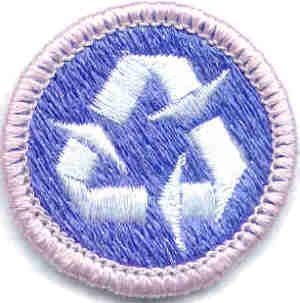
Environmental Science
- Explain the meaning of the following: ecology, biosphere, ecosystem, plant succession, limiting factor. Give an example of each.
- With the help of your counselor, pick an area of 10 acres* for study.
- Visit the area four times for 2 hours each time.
Do this at different times on one day a week for
a month, or if at camp, on four different days of
the week at different times of the day.
- Record the temperature, rain and wind.
- List the animals you saw. Tell what they were doing.
- List the plants you saw.
- Name the kinds of rocks and soil.
- Write about your study in 500 words or more
showing:
- How the climate, topography, and geology have influenced the number and kinds of plants and animals.
- How the living and nonliving elements are interrelated.
- Why it is important that people understand this.
- With your counselor, plan and carry out a project
in ONE of the following:
- The effect of water-holding capacity of soil on plant life. The relation of plant cover to runoff. How both are related to the water and oxygen cycles.
- The influence of land plant life on temperature, light intensity, wind velocity, and humidity. The influence of water plant life on the water environment. How both land and water plants affect animal life.
- Make a report, in the form of a short talk to a Scout group, on what you did in requirement 5.
- Show you understand the following:
- The causes of water pollution. Tell what it does to rivers and lakes.
- The causes of land pollution. Tell what it does to the environment.
- The causes of air pollution. Tell what it does to the environment.
- How some chemicals get into the tissues of animals miles from where they were used.
- Describe what you and others can do to help solve a local problem of air pollution, water pollution, or litter.
- Describe the duties of three positions in environmental science.
* City scouts may pick an area in a large park, if a better place is not available.
![]() Eagle Requirement
Eagle Requirement